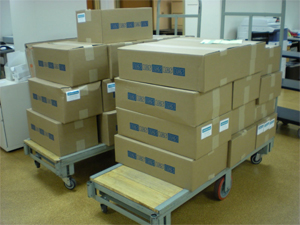 It’s an urge, an itch you can’t scratch. You see a broken book and you instinctively reach for the tape. You want to fix it, make it whole. We know how you feel, we feel the same way. But tape is not the way forward my friends…not for your valuable materials, the ones you want to pass down someday to your kids.
It’s an urge, an itch you can’t scratch. You see a broken book and you instinctively reach for the tape. You want to fix it, make it whole. We know how you feel, we feel the same way. But tape is not the way forward my friends…not for your valuable materials, the ones you want to pass down someday to your kids.
We see a lot of DIY book repairs. I think the people who try to fix our broken books at home are trying to do what they feel is right. The problem is that self adhesive tapes are too strong for brittle paper, it pulls pages out of bindings and often takes several pages at a time. Tape is very difficult or impossible to remove completely unless you use solvents, and it often can’t be removed without damaging the paper surface.
If you have something valuable and it is in need of repair don’t reach for the tape, reach out to a conservator. You can find one through the American Institute for Conservation. On their site they have information on finding and selecting a conservator as well as tips for preserving your treasures.
By the way, the image above shows an older DIY repair done with masking tape. I took a picture because the person carefully colored the tape so it would be less noticeable. I’m not sure it completely worked, but I give him/her credit for trying to make it a less obvious repair.






 I love the new fiscal year, it’s like Christmas in July or September. We got our yearly order of pamphlet binders this week. What do two tons of binders look like? Like a big ol’ pile of presents waiting to be unwrapped.
I love the new fiscal year, it’s like Christmas in July or September. We got our yearly order of pamphlet binders this week. What do two tons of binders look like? Like a big ol’ pile of presents waiting to be unwrapped. Yes, I’m irrationally exuberant about supplies. I’m the same way with paste recipes and statistics, just ask anyone in the lab.
Yes, I’m irrationally exuberant about supplies. I’m the same way with paste recipes and statistics, just ask anyone in the lab. The Head of Acquisitions brought these over after they discovered the books were damaged during shipping. According to her, these would be very difficult to replace so she wanted us to save them if we could. As you can see, these got pretty squished, and the black smudge indicates maybe they got caught in some mechanical thing. They were very bent and had a lot of little page tears.
The Head of Acquisitions brought these over after they discovered the books were damaged during shipping. According to her, these would be very difficult to replace so she wanted us to save them if we could. As you can see, these got pretty squished, and the black smudge indicates maybe they got caught in some mechanical thing. They were very bent and had a lot of little page tears. I put them in the press for a very long time, giving the pages the opportunity to flatten out and stay that way. Then, as any good manager will do, I delegated the treatment to
I put them in the press for a very long time, giving the pages the opportunity to flatten out and stay that way. Then, as any good manager will do, I delegated the treatment to 